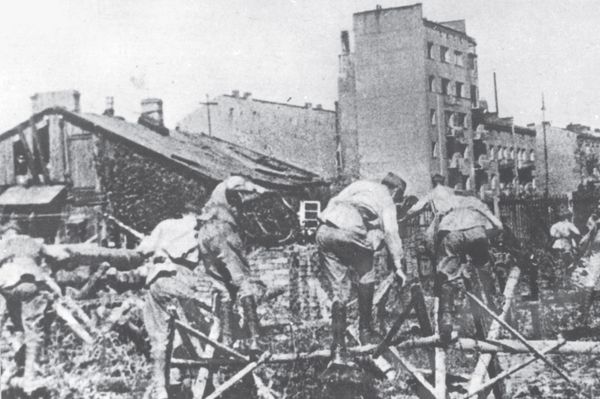Warszawa II (23 page)
Authors: Norbert Bacyk
The new German forces that disembarked in western Warsaw were formally under SS-Obergruppenführer von dem Bach's command. But he lacked the competency to lead frontline troops and Heeresgruppe “Mitte's” staff therefore made the decision that General von Lüttwitz and his XXXXVI Panzer-Corps would take over the defence of the WisÅa line in this sector. In the vicinity of Pultisk, confused officers in the panzer-corps learned that the Kampfgruppe they had been called in to
lead at this time was not even to be formed. Lüttwitz returned to the 9th Army and, on September 18, took over command of the area between MÅociny and Góra Kalwaria. Von dem Bach's group-corps would now, as quickly as possible, set down the Uprising while the XXXXVI Panzer-Corps would defend WisÅa's western bank against Soviet and Polish forces. Under his command were the 25th Panzer-Division, Fallschirm-Pz.Gren. Rgt. 2 “Hermann Göring,” Sickenius' Hungarian units, and in addition General Rohr's and Colonel Schmidt's Kampfgruppe (isolated detached sub-units with engineer soldiers, police, and volunteer units from the east, almost all of whom were of low combat value and carried with them the “rumour” of having murdered civilian residents of Warsaw).

The Polish ZiS-3, 7.62 cm calibre gun from the 1st Light Artillery Regiment, 1st Infantry Division shelling German positions in Praga, September 1944. (WAF)
A Polish and Soviet soldier firing on German positions, Praga, September 13, 1944. (WAF)

Simultaneous with von Lüttwitz taking over command, von Vormann sent an alarming message to Heeresgruppe “Mittes” staff about the situation facing his army, stressing how adverse the conditions had become for all divisions under his command.. He wrote: “Only Division âHermann Göring' can be said to be fully adequate with regard to combat strength and battle-competence. The hard tested SS-divisions âTotenkopf' and âWiking' â as well as the 9th Army â have, during the past several weeks of combat, become so decimated that at this present juncture they are only equivalent to a very mediocre fighting force.” The entire 9th Army just then had in its three infantries, two grenadier, one cavalry and
four armoured divisions; only 30,335 combat soldiers at the frontline, supported by 341 functioning tanks or assault-guns, and 148 artillery batteries equipped with 602 guns. Of these, there were 10,078 soldiers, 268 tanks and 327 guns positioned along the front between Góra Kalwaria and Serock (with the exception of the troops which were in use against the insurgents fighting in Warsaw). The opposition's fighting strength in the same sector, as calculated by the commander of the 9th Army, stood at 66,600 soldiers, 360 armoured vehicles and 920 guns. General Reinhardt was sympathetic to these troublesome observations, but after having read at the end of the report about how “- the uprising had so quickly taken hold in Warsaw,” and about the “... hopeless situation of the army,” he deemed von Vormann as incapable of fulfilling his duties as a commander. Reinhardt was strengthened in his judgement of the general's unstable character during a subsequent telephone conversation with him. That very day he asked Hitler to sack von Vormann. On September 20, an astonished Lüttwitz was informed that he was to hand over command of the XXXXVI Panzer-Corps to General Walter Fries, as he had now been ordered to take over command of the entire 9th Army. From a personal perspective, the new commander took over this post at a fortuitous point in time: The Soviet offensive had weakened considerably and the Warsaw Uprising held on by only a frail thread.

A soldier from the Polish 1st Infantry Division during fighting around St. Florian in Praga, September 1944. (WAF)
Soldiers from the Polish 1st Infantry Division during fighting on Sierakowski Street in Praga, September 1944. (WAF)


Soldiers from the Polish 1st Infantry Division during fighting in Praga, September 1944. (WAF)

Soldiers from the Polish 1st Infantry Division during fighting at a tram stop on KawÄczyÅska Street in Praga, September 1944. The tram is a model A, with an entry-exit door reserved for Germans only. (WAF)

T-34/85 tanks from the 8th Guards Tank Corps, with infantry on board, rolling through the streets of Praga, September 1944. (WAF)

Soldiers from the Polish 1st Infantry Division negotiate barbed wire fences during fighting in Praga, September 1944. (WAF)

A propaganda photo depicting food handouts to Praga's residents by the communist Polish National Liberation Committee (PKWN), September 1944. (WAF)

The crew of a model M4A2 (76) W “Sherman” tank from the 8th Guards Tank Corps are greeted on Targow Street, September 1944. In the background another “Sherman” as well as a ISU-122 assault-gun. (WAF)